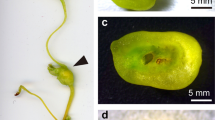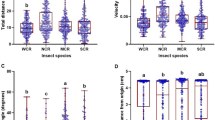Abstract
WHEN cysts of the potato-root eelworm, Hetero-dera rostochiensis Wollenweber, are stimulated with potato-root excretion, larvae begin to emerge from the cyst after a delay of some days: the number emerging per day increases steadily, reaches a maximum, and then declines, even though fresh root excretion is continually supplied ; finally larvae no longer emerge. The reduction in the number of larvae emerging, per day, is connected, to some extent, with the reduction of the number of embryonated eggs as the experiment proceeds, but its cessation is not due to their exhaustion; cysts from which larvæ no longer emerge still contain large numbers of eggs, and larvae will again emerge if the cysts are re-stimulated after an interval. This phenomenon is probably of considerable importance to the eelworm ; all the larvæ contained in a cyst will not emerge in a single season, and the attack on the host plants will tend to be damped. The mechanism by which it is brought about, however, has received little attention. Hitherto it has been thought to be due to some difference in the state of development of the eggs inside the cyst ; but as it is shown by cysts which are some years old, and as an interval of a few weeks between the first and subsequent stimulation is sufficient to cause many more larvae to emerge, this theory is inadequate. Experiments with punctured cysts now show that such a theory is untenable and that the cessation of emergence is due to factors operating within the cyst as a unit.
This is a preview of subscription content, access via your institution
Access options
Subscribe to this journal
Receive 51 print issues and online access
$199.00 per year
only $3.90 per issue
Buy this article
- Purchase on Springer Link
- Instant access to full article PDF
Prices may be subject to local taxes which are calculated during checkout
Similar content being viewed by others
References
Ellenby, C., Nature, 152, 133 (1943).
Boyd, A. E. W., Ann. Appl. Biol., 30, 161 (1943).
Ellenby, C., Ann. Appl. Biol., 31, 332 (1944).
Millott, N., Proc. Roy. Soc., B, 131, 271 (1943).
Stephenson, W., Parasitology, 36 158 (1945).
Author information
Authors and Affiliations
Rights and permissions
About this article
Cite this article
ELLENBY, C. ECOLOGY OF THE EELWORM CYST. Nature 157, 451–452 (1946). https://doi.org/10.1038/157451a0
Issue Date:
DOI: https://doi.org/10.1038/157451a0
This article is cited by
-
Diapause in the nematodeGlobodera pallida
European Journal of Plant Pathology (1994)
Comments
By submitting a comment you agree to abide by our Terms and Community Guidelines. If you find something abusive or that does not comply with our terms or guidelines please flag it as inappropriate.



